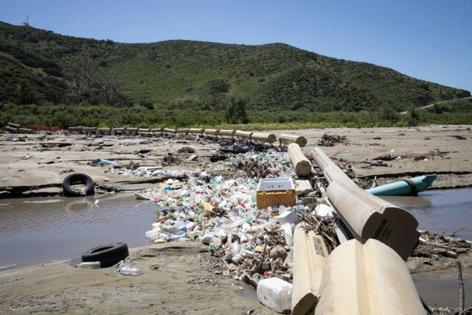The stench from the polluted Tijuana River is so bad it kept a researcher up all night
Published in News & Features
New research backs up the concerns of people who live near the Tijuana River and have long complained that foul air wafting from the polluted waterway is making them sick — irritating their eyes and noses, making breathing difficult and causing headaches. The study indicates they’re being exposed to high levels of the toxic gas hydrogen sulfide.
As the river flows through Baja California, it takes in untreated sewage and industrial waste from Tijuana, then crosses the U.S.-Mexico border into San Diego County, where beaches are regularly closed because the surf is filled with bacteria from the river. Researchers have now gained new insights into how that water pollution is creating air pollution that besets nearby communities.
Using an air-quality monitor nearly half a mile from the river in the community of Nestor, scientists found extremely high levels of hydrogen sulfide, a gas linked to sewage that smells like rotten eggs.
“It validates what the community has been saying for so long,” said Benjamin Rico, a doctoral researcher at UC San Diego and co-author of the study.
The findings show “their complaints are real and valid, and need to be listened to,” he said.
The study, published Thursday in the journal Science, tracked air pollution emanating from a foamy, churning section of the river where water falls from culverts. Rico said it’s a hot spot where the falling water forms bubbles that burst and send fine particles of pollutants into the air.
Recording measurements in September 2024, the researchers found residents in Nestor were exposed to levels exceeding the California standard for five to 14 hours each day. At night, the hourly average reached 70 times the standard, or 2,100 parts per billion, with shorter peaks of at least a minute reaching 4,500 parts per billion.
California’s ambient air-quality standard for hydrogen sulfide is 30 parts per billion averaged over one hour.
“The levels are definitely concerning,” said study co-author Kimberly Prather, a UC San Diego professor of atmospheric chemistry and founding co-director of the Airborne Institute.“Nobody should be breathing that gas day after day — or in this case, night after night.”
Public health officials have described hydrogen sulfide as a nuisance in the area, saying it doesn’t pose immediate risks for residents.
However, studies have found that breathing hydrogen sulfide at certain levels can cause dizziness, headaches, vomiting, cough, chest tightness and depression. Being exposed to high levels in the workplace is a known health hazard, including among workers at wastewater treatment plants. But less is known about the health effects of chronic exposure.
In addition to hydrogen sulfide, the researchers detected hundreds of other gases spreading through communities.
Other research has shown that airborne spray from the Tijuana River contains chemicals including drug byproducts, compounds from tires and personal care products. Residents say they’re also concerned about pollutants discharged from factories in Mexico.
“Nobody knows what the health effects are of breathing that level of hydrogen sulfide gas, plus the viruses, plus the bacteria, plus all the other chemicals that we’ve detected,” Prather said. “It’s just a cocktail of many, many, many chemicals.”
The researchers found high levels of hydrogen sulfide at the same times that residents submitted more complaints to local air quality authorities. They collected data over three weeks during the dry season, when typically the only water flowing in the river channel is wastewater.
Rico said that while spending nights nearby in Imperial Beach, he was awakened by a stench that he described as piercing, something he also heard from residents.
“I couldn’t sleep. It was stressful to be in that environment,” he said.
The researchers wore respirators while working near the river. Yet Rico said even when levels were high, he saw children playing soccer at a school playground close to the monitoring site. It’s one of 11 schools in the area.
He hopes the findings will prompt measures to protect the community, especially children who are exposed on a daily basis.
“This is an urgent and ongoing air quality crisis that needs to be addressed,” he said.
One priority should be upgrading the Saturn Boulevard river crossing, he said, where the culverts create a small waterfall, to eliminate the churning water that spews pollution.
The San Diego County Air Pollution Control District has been providing home air purifiers to residents, and Rico said these efforts should be stepped up to ensure everyone in the area has gas-scrubbing air filters.
In July, the U.S. and Mexican governments signed an agreement pledging to clean up the river.
This week, the U.S. Environmental Protection Agency announced that workers have finished an expansion of the South Bay International Wastewater Treatment Plant north of the border, which handles sewage from Tijuana. The EPA said the upgrade should help address the sewage problem and the foul odors.
Prather said the research underlines the need for further efforts to protect residents. urgent action.
“It’s just not right,” she said. “These people need, and deserve, to not be breathing this air.”
The research team included scientists at UC San Diego’s Scripps Institution of Oceanography, UC Riverside, San Diego State University and the National Center for Atmospheric Research.
The authors said their findings at the Tijuana River point to a need for more research into air pollution coming from other polluted rivers and lakes around the world.
“This is the first study that has shown this many gases coming out of a river, and these types of gases at these levels,” Prather said. “I hope it opens up research around the world to protect people from breathing other things that are coming out of polluted water bodies.”
©2025 Los Angeles Times. Visit at latimes.com. Distributed by Tribune Content Agency, LLC.







Comments